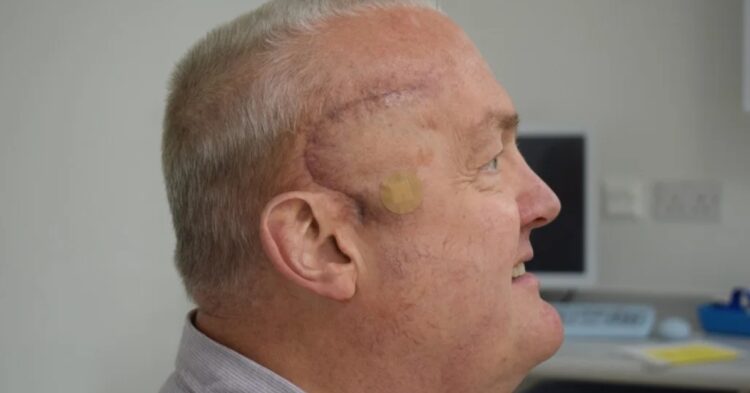A groundbreaking treatment has given a 62-year-old man a second chance at life, with his aggressive brain tumor shrinking by 50% in just six weeks.
This pioneering experimental therapy, part of the CITADEL-123 trial, targets the tumor directly with precision radiation, offering new hope for glioblastoma patients. With no major side effects so far, this innovation could reshape the way we fight some of the most difficult cancers.
A New Hope for Glioblastoma Patients
Embed from Getty ImagesA 62-year-old man, Paul Read, faced a devastating diagnosis of glioblastoma in December 2023, a highly aggressive form of brain cancer with a typically poor prognosis. Given only a year to live, Paul turned to a groundbreaking experimental treatment, part of the CITADEL-123 clinical trial.
This treatment not only offered hope but demonstrated how innovative therapies could dramatically change the future of cancer care.
A Deadly Brain Tumor
Embed from Getty ImagesGlioblastoma, known for its rapid progression and resistance to standard treatments, is one of the most challenging types of cancer to treat. When Paul was diagnosed, doctors gave him a mere year to live.
With limited options and no guaranteed outcomes, he chose to participate in an experimental trial that could offer a potential solution for his condition, despite the high risks involved.
The CITADEL-123 Trial
Embed from Getty ImagesThe CITADEL-123 trial, conducted at University College London Hospitals, is an innovative experimental treatment for glioblastoma patients. Paul was selected to receive this cutting-edge therapy, which uses targeted radiation to attack tumors more precisely than conventional treatments.
This trial is pioneering in its approach, offering new hope to patients diagnosed with glioblastoma, a cancer that typically has a grim outlook.
A Unique Device
Embed from Getty ImagesAs part of the treatment, Paul had an Ommaya reservoir implanted under his scalp. This small device allows doctors to administer radiation directly to the tumor, bypassing the need for more invasive procedures.
The Ommaya reservoir is designed to precisely target the tumor with low-level radioactivity, which significantly minimizes potential damage to healthy surrounding brain tissue, making it a safer alternative to traditional methods.
Targeted Radiation Therapy
Embed from Getty ImagesThis treatment method stands out because of its ability to deliver radiation precisely to the tumor. Unlike traditional radiation therapy, which affects both healthy and cancerous tissue, this technique targets only the tumor cells.
This precision ensures that surrounding brain tissue is spared, reducing the risk of harmful side effects.
A 50% Reduction in Tumor Size
Embed from Getty ImagesThe results of the experimental treatment were remarkable. After only six weeks, scans showed that Paul’s tumor had shrunk by 50%, a rare and impressive outcome for glioblastoma patients.
This dramatic reduction in tumor size demonstrates the potential of this novel therapy to alter the course of an otherwise fatal disease, especially in cases where traditional treatments fail to show such significant improvements
The Significance of Targeted Radiation
Embed from Getty ImagesOne of the main advantages of this treatment is the precision with which the radiation is delivered. Targeted radiation minimizes the damage to healthy brain cells, a major issue with traditional radiation treatments.
By focusing the radiation on the tumor itself, this technique offers a more effective and safer way to combat aggressive cancers like glioblastoma. This approach could mark a new chapter in cancer treatment, providing more hope for patients.
Combining Radiation and Immunotherapy
Embed from Getty ImagesThe CITADEL-123 trial does not stop at just shrinking tumors with targeted radiation. The trial is also exploring the combination of this radiation therapy with immunotherapy, a treatment that strengthens the body’s immune system to fight cancer. The aim is to create a more robust and effective treatment regimen for glioblastoma, helping the immune system to recognize and attack tumor cells more efficiently, possibly leading to even better outcomes.
Expanding the Trial
Embed from Getty ImagesWhile the CITADEL-123 trial is still in its early stages, Paul’s positive results have generated a lot of excitement within the medical community. If this treatment continues to show promise, it could lead to more widespread use and offer new hope for glioblastoma patients worldwide.
The researchers behind this trial are optimistic that, with further developments, this approach could eventually become a standard treatment for aggressive brain cancers.
A New Era in Cancer Treatment
Embed from Getty ImagesPaul’s success story is a shining example of how far cancer treatment has come. The use of innovative technologies like the Ommaya reservoir, combined with precision radiation and future immunotherapy strategies, could revolutionize the way glioblastoma is treated.
For patients like Paul, this groundbreaking trial offers a chance to live longer and with better quality of life, paving the way for a new era of cancer care that may transform the prognosis for many others in the future.
















































